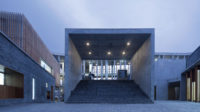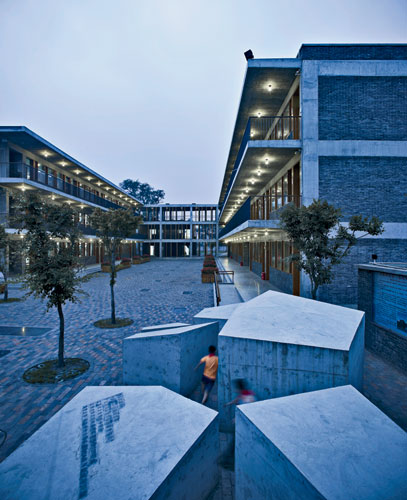Beijing
China is a big country, and Trace Architecture Office (TAO) is leaving its mark all over it. The Beijing-based firm's portfolio includes a teahouse overlooking the Yellow Sea in northeastern Shandong province, a museum in southwestern Yunnan province near the Myanmar border, and a factory in Fujian province 140 miles from the Taiwan Strait. Hua Li, founding principal of TAO, prefers these projects because their locations 'still have diversity; they're not yet globalized.' These places have cultures that retain traces of local material usage and construction techniques and inform TAO's work. In turn, Hua's interest in leaving an architectural trace'both artistically and socially'sets his agenda and gives his firm its name.
' 'Trace' suggests our concern for the social commitment and environmental impact of architecture,' says Hua. He describes TAO's efforts both to manage its aesthetic ideal and its social concerns'balancing individual artistry with communal integrity, expressive forms with socially structured spaces, and global sophistication with local materials. To explain his outlook, Hua offers the example of his Xiaoquan Elementary School in Sichuan province. 'Instead of making a centralized, single building, we designed a cluster of small structures to create a kind of urban condition.' This helps form a community for children who both study and live at the school, as their parents have emigrated from Sichuan for work opportunities. At the same time, TAO inserted specific spaces to encourage exploration. For example, it cut an alcove into a wall and envisioned it as a seating area; children instead filled it with books to create an informal outdoor library. Hua commends the work done by the local contractor on the concrete structure, but 'it's not like a Tadao Ando concrete wall,' he says. He ground out some of the rough spots left over from the formwork. 'With this trace of fixing the problem, you see the process of working. I think it's more meaningful to see the history of the building.'
' 'Trace' is the meaning recorded in the process of making things,' says Hua. 'It makes architecture more like an archaeological object, which expresses its real condition, in contrast to the form that is only an abstraction or representation. I think this is just like history. The history we know is only a small part of the real things that happened. Many other things are hidden or lost or silent. So to work with traces is our effort to reveal these hidden things.' TAO's attitude can also be seen in its working method, which includes building physical models and using a lot of hand drawing. (Hua denies any conscious connection between 'trace' and the paper he so often uses.)
Hua grew up in Lanzhou in the northwestern province of Gansu. 'People there are straightforward and honest,' he says. His neighbors taught him 'to live a simple life, to care about things that are basic and fundamental.' He left home to study at Beijing's prestigious Tsinghua University and then at Yale. There he was influenced by Raimund Abraham, who emphasized poetics over practicality. After graduating, Hua worked in New York for Herbert Beckhard, who had been a partner of Marcel Breuer and brought Breuer's concern for details and tectonics to his work.
In 2003 Hua returned to China and cofounded Universal Architecture Studio, which focused on large sports facilities, mixed-use complexes, and urban design. Working on mega-projects, though, proved frustrating, because they often didn't move beyond the drawing board. Hua wanted to build. So in 2009 he founded TAO to refocus his efforts on smaller works. Each of his projects responds to its particular setting, so there is no identifiable TAO look, which is fine with Hua. 'We don't like to copy forms or repeat ourselves,' he says. 'To me it's more important to understand architecture's social commitment and meaning. I think it has the power to transform culture.'
Trace Architecture Office
FOUNDED: 2009
DESIGN STAFF: 12
PRINCIPAL: Hua Li
EDUCATION: Yale University, M.Arch., 1999; Tsinghua University, B.Arch., 1994
WORK HISTORY: Universal Architecture Studio, 2003–09; Herbert Beckhard Frank Richlan & Associates, 2001–02; Westfourth Architecture, 1999–2001
KEY COMPLETED PROJECTS: Huancui Park Visitor Center, Weihai, China, 2012; Xiaoquan Elementary School, Sichuan province, 2011; Riverside Clubhouse, Yancheng, 2011; Gaoligong Museum of Handcraft Paper, Yunnan province, 2010
KEY CURRENT PROJECTS: Tree Clubhouse, Beijing, 2013; Wuyishan Bamboo Raft Factory, Fujian province, 2013; Film Director’s Center, Beijing, 2013; Kindergarten, Sichuan province, 2014
WEB SITE: www.T-A-O.Cn



























